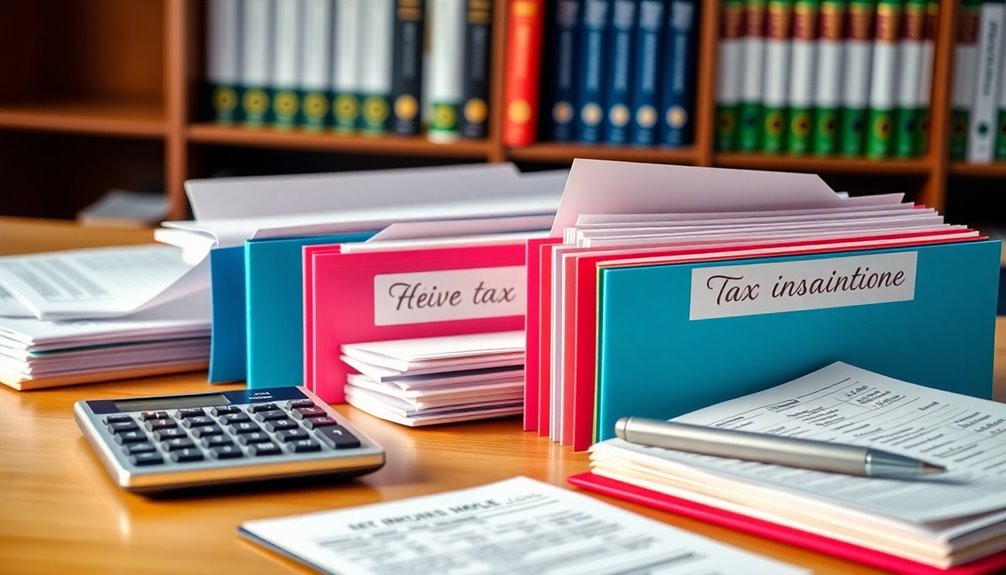To organize your tax documents for your accountant, start by categorizing all your financial info. Group income documents like W-2s and 1099s together. Separate expense receipts, mortgage interest, and charitable contributions in clearly labeled folders or binders. Create digital copies of everything for easy access and backup. Regularly update your documents and maintain an inventory to avoid last-minute scrambles. Communicate with your accountant to ensure you're including everything needed. By following these steps, you'll streamline the process, making it easier for both of you. There's more useful info you can discover to enhance your efficiency further.
Key Takeaways
- Gather all essential documents including income forms, deductions, and investment records in one location for easy access.
- Categorize documents into clear sections such as income, expenses, and investments to streamline the organization process.
- Use consistent, specific labels on folders and files to enhance clarity and quick retrieval of documents.
- Digitize all documents into readable PDFs and maintain a secure cloud storage solution for easy sharing with your accountant.
- Create a detailed checklist of required documents and maintain open communication with your accountant throughout the process.
Categorization of Documents
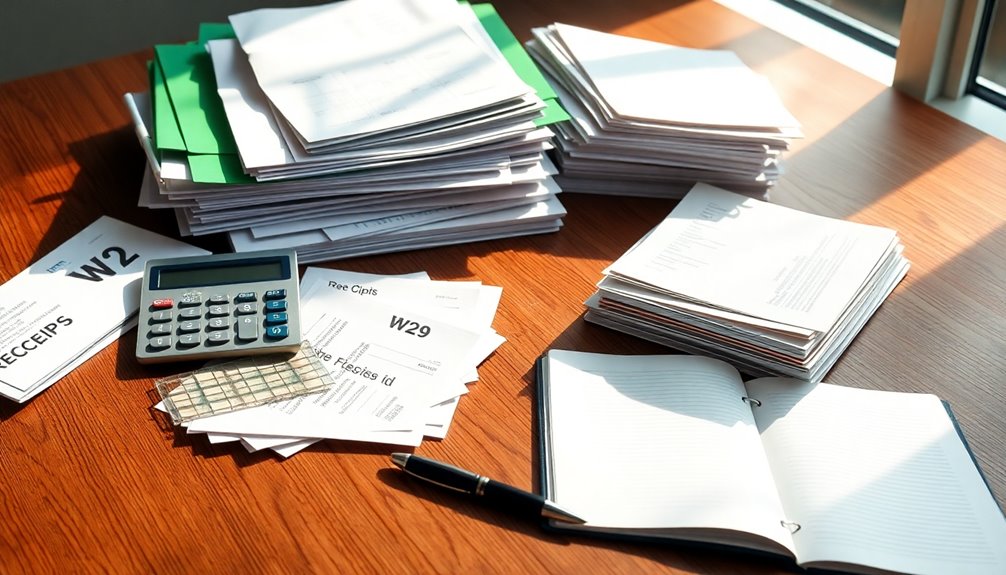
When organizing your tax documents, it's essential to categorize them effectively to streamline the filing process.
Start by grouping your income documents. This includes W-2 forms, which show your wages and withheld taxes, and various 1099 forms that cover different income types, like 1099-INT for interest or 1099-DIV for dividends. Digitizing tax records as PDFs prevents loss from fire or water damage, ensuring your income documents are safe.
Don't forget to document rental income separately from expenses and maintain a summary page for easy reference.
Next, focus on your deduction documents. Collect receipts for medical expenses, record taxes paid, and document any mortgage or investment interest. Gather evidence for charitable contributions and include other miscellaneous deductions like investment expenses or tax preparer fees.
Then, turn your attention to asset documents. Keep investment statements handy along with property documents, business assets, and vehicle-related papers.
Lastly, compile personal documents, ensuring you have identification, dependent-related documents, education expenses, and retirement account contributions well-organized.
Physical Filing System

Organizing your tax documents into a physical filing system can make the entire process smoother and less stressful. Start by gathering all your tax-related documents in one place to prevent misplacement. This includes W-2 forms, 1099 forms, pay stubs, bank and credit card statements, investment records, and any deduction documentation like medical expenses or charitable donations.
Don't forget to check both your mail and email for electronically delivered tax forms.
Next, sort and organize these documents using folders or binders. Separate them into categories—like income, expenses, and investments—and label the folders clearly for easy identification. For efficient retrieval, arrange papers in chronological order or by category and create subfolders for more detailed organization. Organized records ensure that you avoid potential issues with the IRS.
Store your physical documents in a lockable filing cabinet or a safe to protect them from unauthorized access. Consider using water-resistant and fireproof storage options for added security.
Regularly check your storage to ensure everything remains in order and is protected from deterioration or theft. Lastly, maintain a system to track and update your documents, so you're always ready for tax season.
Digital Filing System
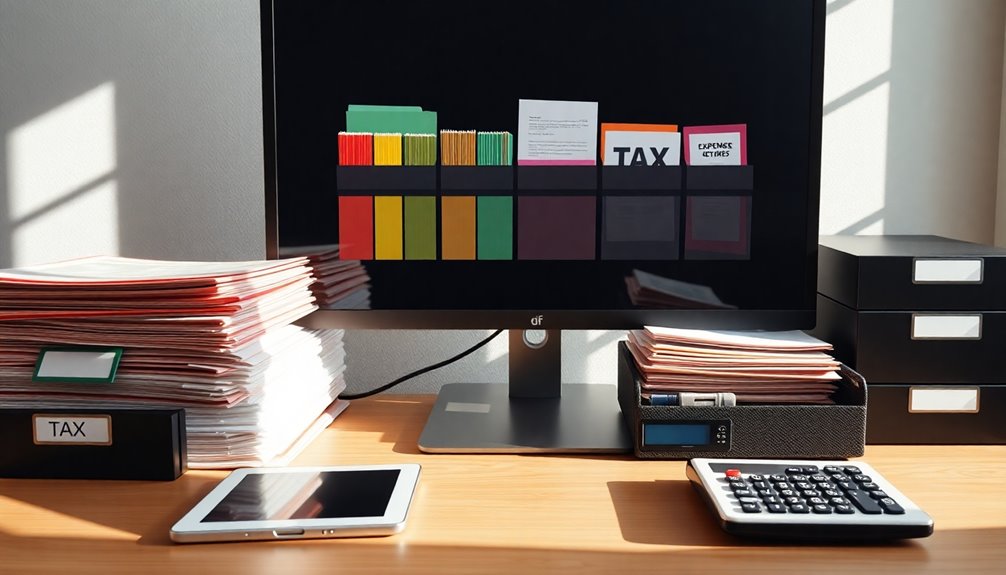
A well-structured digital filing system can save you time and reduce stress during tax season. Start by scanning your tax documents into digital PDFs. This not only prevents loss or damage but also makes retrieval easier. Use scanning apps to convert paper documents into digital files, and ensure you name them clearly for quick identification.
Organize your digital files using a folder structure sorted by year and category. Create separate folders for different document types, like invoices, receipts, and tax forms. This helps avoid confusion, especially when separating personal and business tax documents. Additionally, keep in mind that accurate record-keeping is essential for successful write-offs, as it can help substantiate your claims during tax preparation.
Also, arrange PDF pages logically to enhance organization. To streamline your process further, integrate electronic tax documents with finance and payroll automation software. This makes data transfer seamless and reduces errors, ensuring you have all documents in one place for easy e-filing.
Having everything organized digitally not only improves efficiency but also enhances audit readiness, helping you minimize delays and potential penalties. By adopting this digital filing system, you'll find tax season becomes more manageable and less stressful.
Regular Maintenance and Backup

To keep your tax documents in order and accessible, regular maintenance and backup are essential. Schedule monthly reviews of your financial documents to ensure all income statements, receipts, and expense records are captured promptly. During these reviews, verify that transactions are correctly categorized to avoid discrepancies and remove outdated documents that might clutter your system.
Update your organization system to reflect any changes in income, deductions, or expenses.
For backups, follow the 3-2-1 rule: keep three copies of your data on two different media types, with one copy stored off-site. Utilize cloud storage services like Google Drive or Dropbox for secure access, and store encrypted copies on external hard drives or USB flash drives in a safe location. Implementing regular backups is key to ensuring that you protect your sensitive financial information.
Regularly update these backups to capture new documents and changes throughout the tax year.
Make sure your cloud service complies with data protection regulations to safeguard your information. Consider using tax preparation software that allows easy export of documents for backup.
Lastly, periodically verify the integrity and legibility of your backed-up documents to ensure they remain accessible when you need them.
Collaboration With Accountant

Maintaining a well-organized system for your tax documents not only helps you stay on top of your finances but also facilitates collaboration with your accountant. Start by creating a comprehensive checklist of all necessary documents, including income records, deduction documentation, and any other relevant financial information. Update this checklist annually to reflect changes in tax laws or your personal financial situation. This importance of organizing tax documents can significantly reduce the stress associated with tax season.
Next, organize your documents by category. Divide them into main sections like income, expense receipts, and investment records, using subcategories for clarity. Label each folder with the category and tax year, and arrange documents chronologically to streamline access.
To further enhance collaboration, digitize your documents by scanning paper files into clear, readable PDFs. Store these in a cloud service or on your computer with descriptive file names. Share organized digital folders with your accountant using secure platforms like Dropbox.
Highlight important information on documents for quick reference, and use a numbering system that aligns with your accountant's tax organizer.
Maintain open communication to ensure all necessary information is accessible, minimizing delays and potential penalties. With these steps, you'll foster a smooth working relationship with your accountant.
Efficiency and Compliance
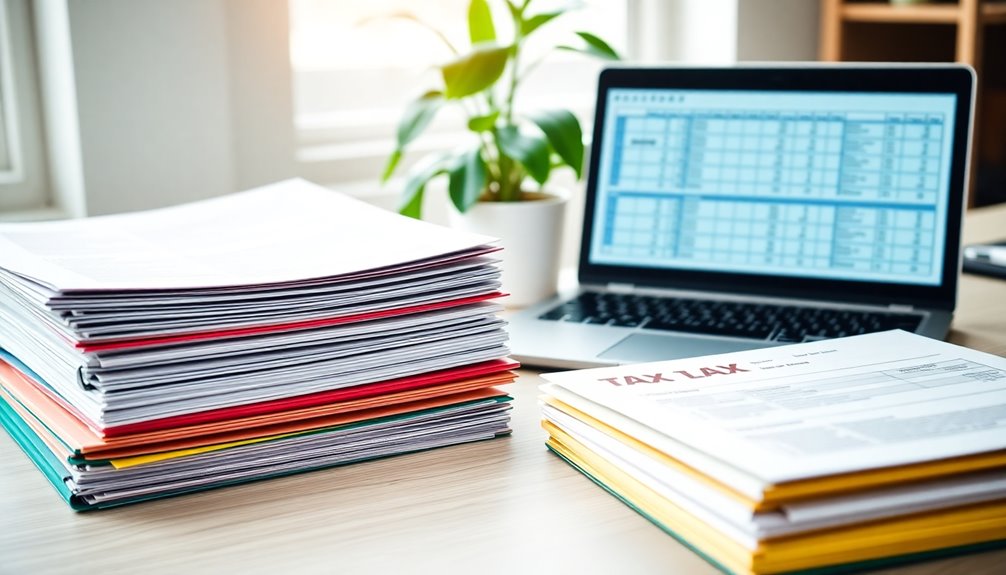
Efficient organization of tax documents is crucial for ensuring compliance with tax regulations. When you categorize your documents into groups like income, deductions, and investments, you streamline the process for both yourself and your accountant.
Use subcategories for larger groups, such as travel, supplies, and utilities under expense receipts. Creating separate folders or digital subfolders for each category helps you stay organized and facilitates quick access. Additionally, implementing a dedicated space for all your tax-related documents can significantly enhance your efficiency.
Consider scanning physical documents and saving them as PDFs, utilizing cloud storage and external hard drives for backups. Compressing PDFs can reduce storage space and ease sharing.
As you organize, make sure each document is dated, and arrange them chronologically within each category. This practice allows for swift identification and minimizes the risk of overlooking vital information.
Maintaining a comprehensive overview of your financial records ensures you have all necessary documents for accurate tax filing. Regularly updating and reviewing your tax documents will help you avoid last-minute scrambles.
Importance of Clear Labels
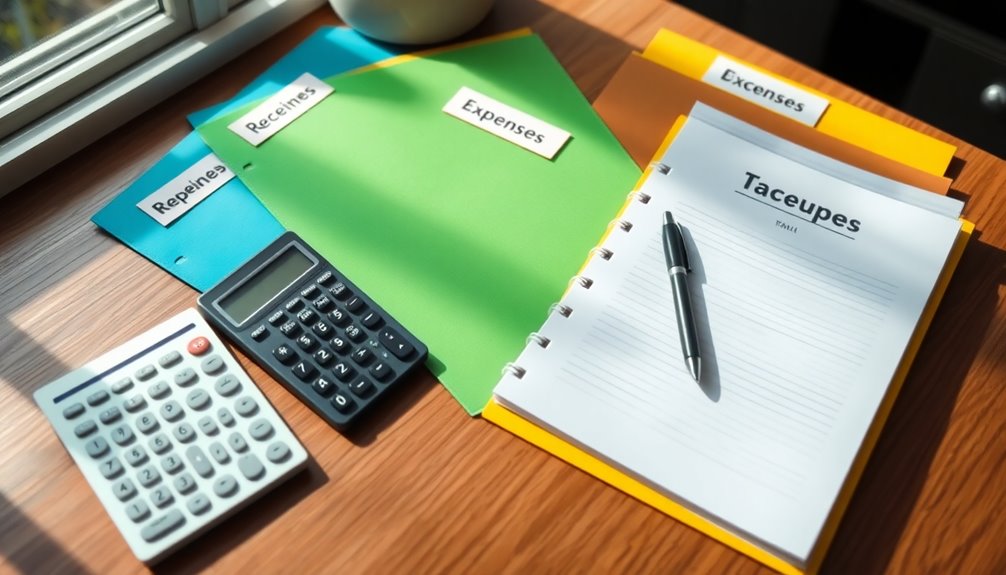
Clear labels play a vital role in organizing tax documents, making it easy for you to file and retrieve essential records. By using clear and readable labels, you ensure that every document category stands out. Choose large, consistent labels that are easy to understand at a glance. Avoid tiny print; clarity is key to reducing confusion and mistakes. Additionally, using transparent labels can enhance the visibility of your document categories, making it even easier to locate specific records.
When categorizing your documents, opt for generic terms like "insurance" or "bank" rather than specific company names. This way, your labels remain relevant over time. Avoid overly broad labels like "Documents," which don't indicate the actual contents. Instead, categorize by type, such as income or assets, and use subcategories for more specificity, like "Insurance, Car" or "Insurance, Health."
Keeping an inventory of where documents are stored further enhances organization. By regularly updating this inventory, you can quickly identify misplaced items and maintain an effective tracking system.
Ultimately, clear labels ensure long-term accessibility, facilitating quick retrieval during audits or when referencing past returns, so you can validate deductions and credits accurately without unnecessary frustration.
Document Organization Tools
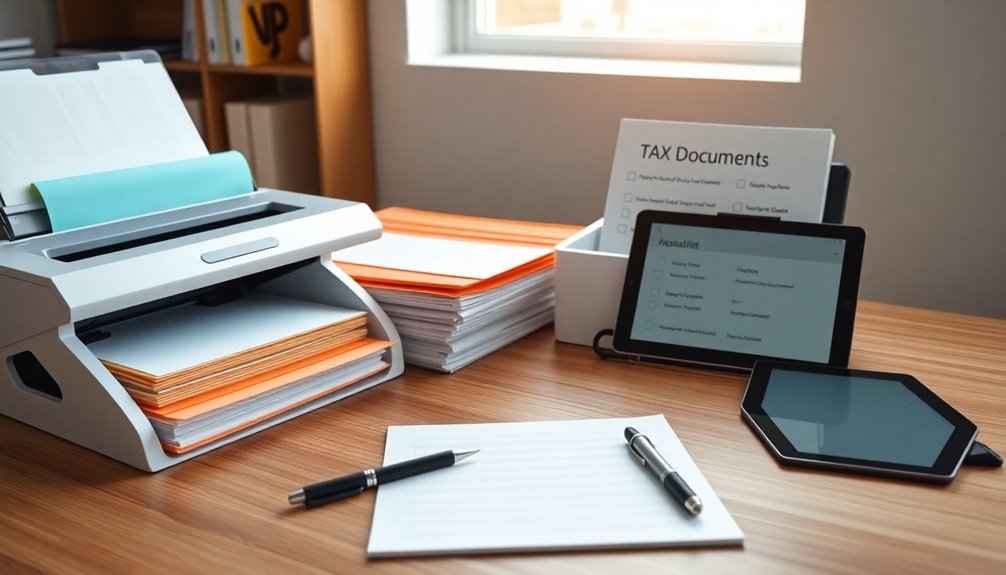
When it comes to organizing tax documents, leveraging the right tools can make a significant difference in streamlining your process. Automated organization tools like GruntWorx Organize can save you time by automatically sorting, bookmarking, and labeling your scanned documents. It identifies each document and adds the issuer's name, making it easy for you to find what you need quickly through searchable bookmarks. Additionally, these tools increase productivity by allowing tax professionals to focus on high-value tasks.
Cloud-based document management systems, such as Thomson Reuters GoFileRoom and Onvio Firm Management, create a paperless environment that enhances collaboration and security. You can access your documents anytime, anywhere, while limiting permissions to protect sensitive information.
Consider using a client portal like LedgerDocs TaxDocs, which allows clients to upload their documents directly. This tool not only sorts these documents into individual client folders but also features automated data extraction and categorization, further minimizing your workload.
Preparing for Tax Season

Preparing for tax season involves gathering several essential documents that'll simplify the filing process. Start by collecting Social Security numbers and dates of birth for yourself, your spouse, and any dependents. Don't forget a government-issued photo ID and a copy of last year's tax return, as these can provide helpful context. If you have any IRS or state notices, include those as well.
Next, categorize your income documents. Gather W-2 forms from all jobs, along with 1099 forms for any self-employment income or unemployment benefits. If you receive Social Security or pension income, make sure to have the relevant 1099-R and SSA-1099 forms handy. Additionally, ensure you have accurate record-keeping to help identify potential credits.
For deductions and credits, compile documentation for childcare costs, education expenses, and charitable donations. Keep records of your home mortgage interest, property tax payments, and health insurance documents.
Finally, organize your expense and asset records. Collect receipts, estimated tax payment records, and bank statements. Don't overlook investment records and rental income details, as they could impact your tax situation.
Frequently Asked Questions
What Documents Should I Keep for Future Tax Years?
You should keep a variety of documents for future tax years.
These include income documents like W-2s and 1099s, expense receipts for deductions, and asset records such as home purchase documents.
Don't forget about business-related paperwork if you're self-employed, like invoices and contracts.
It's wise to retain these records for at least three years, ensuring you have everything you need to support your claims and navigate any potential audits.
How Long Should I Retain Tax Documents?
You should retain tax documents for at least three years after filing your return or its due date, whichever is later.
If you underreport income by more than 25%, keep records for six years.
For bad debts, hold onto documents for seven years.
If you claim foreign tax credits, you'll need them for ten years.
Always store records securely and dispose of them responsibly when the retention period expires.
Can I Use Mobile Apps for Document Organization?
Absolutely, you can use mobile apps for document organization!
Apps like TaxACT DocVault and TaxCaddy let you upload, categorize, and securely store your documents right from your phone. They offer features like electronic signatures and integration with tax software, making your life easier.
Plus, with cloud storage, you can access your files anytime, anywhere. So, don't hesitate to embrace these tools for a more efficient document management experience!
What Are the Benefits of Digitizing Tax Documents?
Digitizing tax documents offers you numerous benefits.
You'll save on costs by cutting down on printing, paper, and storage fees. Automation increases efficiency, allowing you to process documents faster while minimizing errors.
Enhanced accuracy means quicker audits and refunds. Plus, storing records digitally secures them against data breaches and ensures compliance with regulations.
Ultimately, you'll enjoy a streamlined, responsive experience that makes managing your tax documents much easier and more efficient.
How Do I Handle Missing Tax Documents?
If you're missing tax documents, first contact your employer or payor for a replacement.
Make sure your address is correct if the document was mailed.
If they're unresponsive, reach out to the IRS at 800-829-1040 for help.
You can also use IRS Form 4852 as a substitute for missing W-2 or 1099 forms.
Remember to include your last paystub for income estimates if necessary.
Conclusion
By organizing your tax documents effectively, you're not just making life easier for your accountant; you're also ensuring compliance and maximizing efficiency. Keep everything categorized, labeled clearly, and regularly maintained, whether you choose a physical or digital filing system. Don't forget to collaborate with your accountant and use the right tools to streamline the process. With these strategies in place, you'll be well-prepared for tax season and can approach it with confidence.
